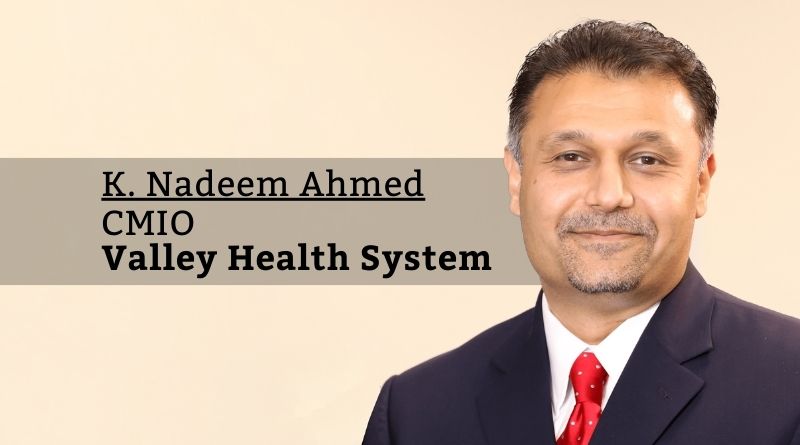Technology to Optimize Clinical Workflows: Key Factors for Success
By K. Nadeem Ahmed, M.D., CMIO, Valley Health System
Before joining Valley Health, I served as the Global CMIO for The Aga Khan University (AKU) and its international network of hospitals. In addition to co-founding and managing a busy internal medicine hospitalist practice, I served as an executive physician advisor for dozens of healthcare systems across the United States and internationally. Appreciating the impact that technology has on people’s lives, I’ve always been a strong proponent of pushing technology to its limits to help improve healthcare.
In the ever-evolving journey of advancing healthcare, the pursuit of optimizing clinical workflows is riddled with stories of failure and success. Over the years, I have witnessed both success and failure with different hospital systems using the same technology, no matter how fantastical its developers claimed it to be. From grappling with inefficient processes to celebrating breakthroughs in patient care delivery, there are key elements of a healthcare system ecosystem that must be present to ensure ongoing success with clinical workflow optimization. In and of itself, simply plugging in a new software system into a clinical workflow process does not improve outcomes. So, what are the other main ingredients if technology is seen as a catalyst for improvement?
The journey to optimize clinical workflows with new technology is not without its challenges, but it is also rich with opportunities for growth and innovation.
In my recent role as the global CMIO for a multinational healthcare network, one of our academic hospital systems, with its busy main campus and over fifty outpatient clinics, embarked on an ambitious initiative to implement a state-of-the-art electronic health record (EHR) system aimed at streamlining clinical workflows and enhancing care coordination. However, despite significant investments in technology, I realized that our efforts would be hampered by several pitfalls:
- Poorly Defined Governance Structure: Our clinical governance framework lacked clarity and accountability, leading to conflicting priorities and decision-making bottlenecks. Without clear governance structures, key stakeholders would be left feeling disconnected and disempowered, hindering our ability to drive meaningful change. In the past, administrators simply shrugged off busy clinical providers who could not reliably participate in the frequent committee meetings and would make clinically impacting decisions without them.
- Lack of Clinical Engagement: While the EHR system promised to revolutionize how care was delivered, its adoption was initially hindered by a lack of buy-in from frontline clinicians. Without their active participation and feedback, the system would fail to align with existing workflows, resulting in frustration and resistance.
- Absence of a Clinical Informatics Team: Another critical factor contributing to our struggles was the absence of a dedicated clinical informatics team. Without experts to bridge the gap between clinical workflows and technology solutions, we would face significant challenges in optimizing system functionality, providing user support, and driving user adoption. Understanding the end-user component is best done by having a dedicated team of experienced end-users developed into a core team of clinical informaticists.
With my prior experiences working with almost two dozen other hospital systems, it was generally accepted that any major effort to improve clinical workflows requires executive sponsorship and likely investment in IT infrastructure and resources; and such was the case at my organization. However, as frequently experienced, dealing with the three factors above was under-appreciated and alarmingly, at some organizations, actively discouraged! As CMIO, it was my mission to have these key factors addressed immediately. Despite the setbacks encountered along the way, our organization evolved, learning valuable lessons from past failures and leveraging them to inform our approach going forward. Through a concerted effort to foster innovation and collaboration, we ultimately achieved success with key initiatives:
- Establishing Clear Governance Structures: We revamped our clinical governance framework, establishing clear lines of accountability and decision-making authority. Committee membership included technology support leaders, clinical end-user representatives, and administrative leadership. This enabled us to align our initiatives with organizational goals, streamline processes, and ensure that resources were allocated effectively to support our strategic objectives.
- Engaging End-Users from the Onset: Recognizing the importance of clinician input, we actively involved frontline staff in designing and implementating technology solutions. We fostered a culture of ownership and empowerment by soliciting feedback and tailoring our approach to meet their needs, driving widespread adoption of new workflows.
- Building a Dedicated Clinical Informatics Team: Perhaps the most transformative step we took was the establishment of a dedicated clinical informatics team. Comprising expertise in healthcare IT, workflow analysis, and user support, this team played a central role in optimizing system functionality, providing user training and support, and driving continuous improvement efforts.
With the formation of end-user workgroups led by our clinical informatics team, we were able to solicit feedback, identify targeted training and support, and leverage the expertise of our clinical informatics team to ultimately achieve widespread acceptance and adoption. Our hospital went live with the new EHR system with almost 100% clinical adoption. Seemingly overnight, we successfully transformed our healthcare organization into an integrated health data ecosystem, which would further enable data-driven analytics for ongoing clinical workflow optimization, as well as education and research. This journey of clinical transformation served as a catalyst for cultural change, reinforcing the importance of collaboration and teamwork between all the various departments.
The journey to optimize clinical workflows with new technology is not without its challenges, but it is also rich with opportunities for growth and innovation. By reflecting on past failures and successes, we gain invaluable insights that inform our approach to driving meaningful change in healthcare delivery. Through a combination of cohesive governance, end-user engagement, and dedicated support, we can successfully apply innovative technologies to help navigate the complexities of workflow optimization with confidence, ultimately improving patient outcomes and advancing the mission of healthcare excellence.



